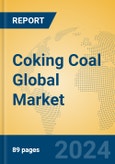- Introduction to the Coking Coal Industry
India stands out as a growth market, with steelmakers like Tata Steel, JSW, JSPL, and AMNS expanding capacity - JSW targeting 42 million tonnes by 2027, Tata Steel reaching 26.6 million tonnes by 2025, JSPL aiming for 15.9 million tonnes by 2026, and AMNS adding 1.5 million tonnes by late 2025. Smaller players like Shyam Metallics also boost demand with new coke ovens. The Russia-Ukraine war since 2022 continues to impact energy and coal markets, driving supply chain adjustments. The industry is characterized by its dependence on steel cycles, concentrated supply from Australia and China, and a shift toward cleaner production methods.
Market Size and Growth Forecast
The global coking coal market is projected to reach USD 81 billion to USD 84 billion by 2025, with an estimated CAGR of 4.5% to 5.5% through 2030, driven by steel demand in emerging markets.Regional Analysis
Asia Pacific expects a growth rate of 5% to 6%, with India and China leading due to steel expansion, though China’s output decline moderates growth.Oceania anticipates 4% to 5%, with Australia as a key exporter to Asia.
North America projects 3% to 4%, with the U.S. supporting domestic steel.
Europe expects 2% to 3%, tempered by decarbonization efforts.
South America and Africa anticipate 3% to 4%, with limited but growing steel needs.
Application Analysis
- Iron and Steel: Projected at 4.5% to 5.5%, dominates due to global steel demand.
- Chemical and Pharmaceutical: Expected at 3% to 4%, a niche use in coke byproducts.
- Paper and Pulp: Anticipated at 2% to 3%, minor but stable.
Type Analysis
- Hard Coking Coal (HCC): Projected at 4.5% to 5.5%, preferred for high-quality steel.
- Semi-soft Coking Coal (SSCC): Expected at 4% to 5%, used in blended steel production.
- Pulverized Coal Injection (PCI): Anticipated at 4% to 5%, growing in cost-effective steelmaking.
Key Market Players
- Shanxi Coking Coal: A Chinese leader, Shanxi dominates coking coal supply.
- JZEG: A Chinese firm, JZEG serves steel industries.
- China Pingmei Shenma: A Chinese company, Pingmei integrates coal with chemicals.
- Kailuan Group: A Chinese player, Kailuan focuses on metallurgical coal.
- HBMG: A Chinese firm, HBMG supports regional steel.
- Huainan Mining: A Chinese company, Huainan supplies coking coal.
- Lu’An Green Energy: A Chinese leader, Lu’An targets green coal tech.
- Coal India Limited: An Indian giant, Coal India boosts coking coal output.
- BHP: An Australian firm, BHP exports high-quality coking coal.
- Jindal Coke Limited: An Indian player, Jindal serves steelmakers.
- Anglo American: A UK-based company, Anglo focuses on metallurgical coal.
- Arch: A U.S. firm, Arch targets coking coal markets.
Porter’s Five Forces Analysis
- Threat of New Entrants: Low. High barriers limit entry.
- Threat of Substitutes: Moderate. Alternatives like hydrogen steelmaking emerge.
- Bargaining Power of Buyers: Moderate. Steel firms negotiate, but supply is tight.
- Bargaining Power of Suppliers: High. Few producers control quality coal.
- Competitive Rivalry: High. Global players compete on quality and price.
Market Opportunities and Challenges
Opportunities
- Steel Growth: India’s expansion drives demand.
- Export Markets: Australia benefits from Asian needs.
- Technological Advances: Cleaner steel tech sustains coal use.
- Infrastructure Demand: Global projects boost steel.
- Emerging Markets: Africa offers potential.
Challenges
- Decarbonization: Green steel threatens coal.
- Supply Disruptions: Geopolitical risks impact trade.
- Price Volatility: Steel cycles affect coal margins.
- Regulatory Pressure: Emission standards challenge operations.
- Substitution: Hydrogen and scrap steel compete.
This product will be delivered within 1-3 business days.
Table of Contents
Companies Mentioned
- Shanxi Coking Coal
- JZEG
- China Pingmei Shenma
- Kailuan Group
- HBMG
- Huainan Minging
- Lu'An Green Energy
- Coal India Limited
- BHP
- Jindal Coke Limited
- Anglo American
- Arch








